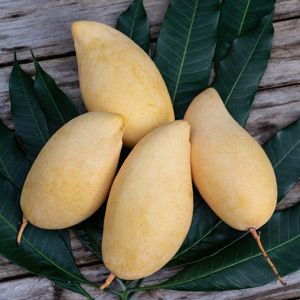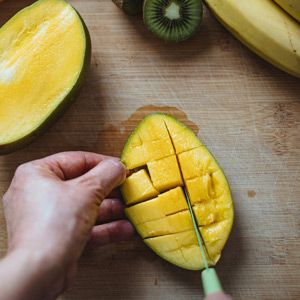Mango: Your Pet Will Enjoy This Antioxidant-Loaded Fruit
This fruit is known for its sweet and refreshing flavor, which makes it a popular snack during summertime for humans. If you're thinking about giving this to your pet, there are some things to consider first.

STORY AT-A-GLANCE
- Mango is rich in beta-carotene (vitamin A precursor), a compound that also gives the fruit its bright color. Research has shown that it’s a major source of antioxidants that may promote wellness in animals
- Another antioxidant in mango is quercetin, which has cognitive benefits as well as anti-inflammatory qualities
- The main bioactive compounds found in mangoes are polyphenols, such as mangiferin, catechins, quercetin, kaempferol, gallic acid and benzoic acid, which are compounds associated with the prevention of degenerative diseases
- When feeding mango to your pet, give them the flesh only. The large seed in the middle can be a choking hazard
When it comes to tropical fruits, mango is certainly one of the more popular yet unique picks. Its deep yellow color and sweet, soft flesh are hallmarks of this fruit, which you can enjoy in various ways. Whether eaten raw, thrown in a blender to make a healthy smoothie or tossed in a salad, mango has something for everyone.
But does mango offer something for your pet as well? Based on the published research, the answer is yes. Small pieces of mango can be given as occasional healthy treats, or added to your pet's species appropriate, nutritionally adequate meals in small amounts as food toppers. However, there are some things you need to know before adding this fruit to your pet's diet.
Did You Know?

The name mango most likely comes from the word "manna," which is the Malayalam word for the fruit. The Portuguese adopted this word as "manga" when they arrived in Kerala in 1948.1
Mangiferin Is Mango's Main Health-Promoting Compound
Bioactive compounds are the health-promoting molecules found in plants. Extensive research has been done regarding these compounds in an effort to learn what they can do for optimal health, both for humans and animals.2 In the case of mango, one of its main bioactive compounds is mangiferin.
According to a study published in 2017, mangiferin may play several roles and has antioxidant, antimicrobial, antidiabetic, anticancer and immunomodulatory properties.3 While there's no research done specifically on companion animals regarding mangiferin, lab tests were done on rats, which may give us some insight on how it may benefit dogs and cats.
For example, research published in the Journal of Ayurveda and Integrative Medicine noted that mangiferin has a cardioprotective effect in animal models, and the compound helped increase tissue antioxidant levels, as well as other markers such as lipid profile, histological score and mortality.4
In a 2003 study, again testing mangiferin, researchers discovered that it has anthelminthic and antiallergic properties. They administered mangiferin to test rats infected with Trichinella spiralis, a roundworm parasite, which led to a decrease of parasitic larvae in the musculature. In addition, oral treatment had an inhibiting effect on mast cell degranulation.5
Gallic Acid in Mango May Be Good for Pets
Another bioactive compound present in mango is gallic acid.6 Similar to mangiferin, it may provide health benefits to your pet, and one study done on animals showed promising results. In a 2022 paper published in Frontiers in Immunology, gallic acid (GA) was tested on dogs and was able to reduce oxidative stress and inflammatory response caused by environmental stressors.7
Another benefit that researchers noted is improved gut health. During the course of their study, they observed that the fecal matter of the puppies had a lower presence of pathogenic bacterial strains with a simultaneous uptick in probiotic strains.8
Mango Has Another Antioxidant: Quercetin
According to a 2017 study from Nutrients, one of the antioxidants inherent in mango is quercetin,9 which research has shown to have multiple health benefits among humans, such as anti-inflammatory and antimicrobial properties.10 What's interesting about quercetin is that it can benefit animal health as well.
In one animal model study, quercetin was shown to have a neuroprotective effect, which may have potential for treating Alzheimer's disease in humans, but may also benefit other species' cognitive health. To provide further context, researchers observed that quercetin inhibited amyloid-beta production, which resulted in better cognitive function in the test animals.11
In another paper, dogs that received a diet enriched with polyphenols (including quercetin), along with antioxidants and polyunsaturated fatty acids, managed atopic dermatitis better.12 Quercetin has also been observed to have anti-inflammatory potential, especially when combined with ascorbic acid (vitamin C).13
Mango Fun Fact

Mango first entered Western culture thanks to Portuguese explorers who brought the fruit from Asia to Brazil in the 16th century. From there, it was grown in Barbados in 1742, then spread to Mexico in the 19th century.14
How to Serve Mango to Your Pet
When buying mangoes at the grocery store or farmers market, you're safe with choosing regularly grown varieties. According to the Environmental Working Group, mangoes rank No. 13 in their "Clean Fifteen" list, which is a compilation of produce with the least amount of pesticides based on their testing methods.
"When giving mango to your pet, only the flesh should be eaten, ideally raw, so they can get the full benefits of the fruit."
To safely share mango with your pets, peel the fruit and remove the large seed (or pit) from the center of the fruit as it's a choking hazard.15 Make sure to chop the fruit into tiny, bite-sized pieces. Here's how you can dice a mango easily:16
- With the mango stem on top, cut vertically about a quarter of an inch away from the midline.
- Do the same slice on the other side.
- Using a knife, cut the flesh in a grid pattern without going through the skin.
- Use a large spoon to scoop out the mango cubes and place into a container.
While mango can be a tasty snack for your pet, be careful with the amount you're giving them. As a general rule, treats should be less than 10% of your pet's daily caloric intake. Another reason for following this rule is because mango contains a fair amount of sugar, totaling 1.41 grams per tablespoon.17
Top Mango Producers in the World

India is the world's top producer of mangoes, with a harvest of nearly 20 million tons annually. China is at second place, but their production is just above 4 million tons. Third place belongs to Thailand at around 3.5 million tons.18

The Sustainability of Growing Mangoes
Mangoes are readily available around the world, but have you ever wondered what their effects on the environment are? If you're conscious about your carbon footprint, when it comes to mangoes, don't worry. The industry surrounding this fruit has a minimal impact on the environment.
According to an environmental paper published by the National Mango Board, total gas emissions from mango production (from farms to retailers) average 0.45 kilograms of carbon dioxide per kilogram of harvest. This is lower compared to tomatoes, which range between 0.8 to 5.6 kilograms of carbon dioxide per kilogram of harvest, or beef, which is around 14 kilograms of carbon dioxide per kilogram of product.19
Furthermore, planting more mango tress may benefit the environment. According to the same paper, the trees can help with carbon sequestering.20 Based on these findings, it's safe to say that the mangoes you're buying contribute to sustainability.
Your Pet Can Have Mango, but in Moderation
Mangoes are best enjoyed in raw form, which is also the best way to give this sweet fruit to your pet, in very small amounts, because of the sugar content. Dehydrated mango has a much higher sugar content and should be avoided for pets.
Sources and References
- 1 Britannica, "Mango"
- 2 Oxidative Medicine and Cellular Longevity, "Bioactive Compounds of Food: Their Role in The Prevention and Treatment of Diseases 2021"
- 3 Lipids in Health and Disease volume 16, Article number: 84 (2017)
- 4 J Ayurveda Integr Med. 2017 Apr-Jun; 8(2): 62–67, Abstract
- 5 Phytother Res. 2003 Dec;17(10):1203-8, Abstract
- 6 Nutrients. 2017 May; 9(5): 525, Abstract
- 7,8 Front Immunol. 2021; 12: 813890, Abstract
- 9 Nutrients. 2017 May; 9(5): 525, Botanical Characterization
- 10 ACS Omega. 2020 May 26; 5(20): 11849–11872, Abstract
- 11 Int J Mol Sci. 2019 Jun 5;20(11):2761, Abstract
- 12 BMC Vet Res. 2019; 15: 220, Abstract
- 13 Inflammation. 2017 Jun;40(3):980-994, Abstract
- 14 Wisconsin Department of Public Information, "Mango"
- 15 American Kennel Club, "Fruits and Vegetables Dogs Can or Can’t Eat"
- 16 Mango.org, "How to Cut a Mango"
- 17 USDA, "Mangoes, Raw"
- 18 IHS Markit, "Article: Special Report: The world is looking beyond India for supplies of mango purée"
- 19,20 Mango.org, "Sustainability Assessment for the Mango Industry," Overall Findings, pg. 2











